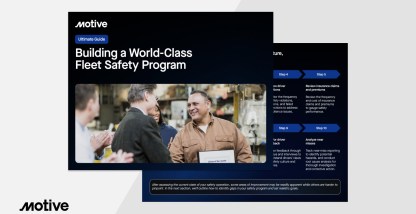As Baby Boomers retire from the transportation industry in large numbers, the exodus is contributing to a driver shortage that the ATA puts near 80,000. The next generation of drivers should be waiting in the wings, but they’ve sought a better work-life balance elsewhere. So fleets must work harder to retain drivers, and to keep them motivated and safe. Fortunately, there’s a way to accomplish all of this at once. It’s called a safety incentive program, and it’s the key to improving driver safety.
Helpful tips for planning a driver incentive program
First, clearly define what your incentive program should achieve. Here are five suggestions to help you prioritize as you plan a driver incentive program.
1. Set strategic goals
Before taking the first step, know the intended outcomes. If reducing collisions is the goal, you could build incentives to increase following distance, eliminate cell phone use, or practice safe speeds. Whichever behaviors you focus on, driver incentives should support the fleet’s overall safety mission and align with corporate goals.
In a recent blog post, American Family Insurance reports that before launching an incentive program, “management must assure that the organization has the proper equipment, hiring procedures, training programs, supervision techniques, and record keeping in place – the basic components of a well-managed fleet safety program.”
2. Keep it simple
As with any new initiative, the easier a driver incentive program is to understand and act upon, the greater the chances of success. “Keep incentive programs simple, be straightforward with ground rules, and communicate those rules to all employees,” Safety + Health Magazine advises. When fleet safety incentive programs are too complicated, they fail before even making an impact. Start with the big picture and build goals around it. Simplifying the incentive program makes it easy for managers to administer and drivers to follow.
3. Use data from safety technology to decide which behaviors to incentivize
The Motive AI Dashcam captures video of unsafe driving behaviors, then automatically uploads them to a fleet’s Safety Hub for follow-up. In designing an incentive program, look for videos in the Safety Hub marked “high severity” or “critical.” Let the unsafe behaviors in those videos direct your focus.
If texting and driving is a problem in your fleet, consider an incentive that gives drivers points for each day they don’t reach for their phone. Drivers could use those points to buy gear and electronics from the company store. Short-term goals are more likely than annual awards to inspire a change in behavior. When designing a driver incentive program, aim for short-term incentives that are easy to track.
4. Gain buy-in from top brass so drivers buy in too
When the message about a new driver incentive program comes from the CEO, managers and drivers will take the program seriously. Executive support bolsters the program’s credibility.
5. Communicate expectations
Launching a driver incentive program is similar to rolling out new safety technology. Transparency is the key to obtaining driver acceptance. When launching an incentive program, explain to drivers why you chose to incentivize safety. Have there been too many near misses lately? Too many accidents? Share those details with the team. Make sure drivers can see how their performance compares to their peers. Also educate them on how their performance is measured. A little friendly competition can motivate drivers even more.
Creative tips for keeping drivers engaged in safety
Once a safety incentive program has launched, fleet and safety managers will be responsible for keeping it fresh, fun, and motivating. Here are proven ways to keep drivers invested in safe performance.
1. Diversify rewards
Though it may be tempting to reward drivers with cash all the time, it’s best to offer a combination of rewards. According to American Family Insurance, “While the first thought for providing rewards may be to provide cash incentives, many organizations avoid this as they feel it does not provide lasting recognition. On the other hand, many organizations have found a combination of cash and [company] merchandise works well.”
Diversifying will keep your driver incentive program fresh and drivers engaged. Allocating different levels of recognition to various achievements will also set larger accomplishments apart from smaller ones.
2. Give timely praise
Positive feedback given shortly after a safety achievement is most impactful. When safe actions are rewarded and reinforced promptly, it sends the message that safety is valued and important. When rewards are closely tied to specific driving behaviors, such as leaving space around the vehicle, reasonable speeds, or safe lane changes, drivers will begin to associate those behaviors with positive recognition.
Waiting too long to reward excellence or improvement may confuse drivers who may not remember the details of an event weeks later. For praise to be most effective, Inc. magazine writes, “do it immediately. You’re going to lessen the impact of the praise if you wait too long.”
3. Praise drivers publicly
Public recognition can motivate drivers to perform their best, so look for opportunities to acknowledge drivers before their peers. Many fleets celebrate their most improved performers during safety meetings, or host awards banquets for their safest employees. Others list the month’s top drivers in the breakroom.
“Social recognition can be even more meaningful to employees than tangible rewards,” writes Kellie Wong in an incentives article for Achievers.com. “Even a simple ‘thank you’ can be enough to keep someone motivated.”
4. Gamify driver incentives to make them fun
A trophy that makes the rounds with the company’s safest drivers. A points system that lets drivers buy cool company swag. A commemorative wrap for a driver’s vehicle. They’re all creative ways to show appreciation for safe drivers.
Gamification takes the principles of board games and video games and applies them to the workplace. Some fleets reward drivers for going a certain number of miles without an accident. Others give on-the-spot bonuses for avoiding a collision. There are countless ways to gamify incentives, so go ahead and get creative with them.
Use metrics from your AI-powered safety platform to show that a driver is improving and worthy of recognition. When looking for drivers to acknowledge, Motive’s DRIVE risk score can help. Drivers with excellent scores are listed in deep blue in the Safety Hub. As your team’s strongest performers, they should be rewarded. When incentivizing drivers for improvement, you could reward drivers who advance from fair to good.
5. Give drivers visibility into their performance
Access and visibility have become sources of validation for drivers. Especially since the alternative is to be left out. Drivers like to feel part of a larger mission, and giving them insight into their performance helps achieve that.
“Giving employees visibility into company goals and hard data sends a message that they’re a trusted and integral part of the team,” writes BrightGauge, a data management platform. “It gives them a sense of ownership and accountability over their work.”
When a driver takes quick action to avoid an accident, for example, video captured by Motive’s AI Dashcam is automatically uploaded to the Motive Driver App for the driver’s review later. Having video proof of the incident backs up the driver’s side of the story and brings their bravery to light. The driver’s manager can then share the driver’s achievement with the broader team, inspiring everyone.
View the 2023 Driver App updates.
6. Make driver incentives meaningful
If a driver goes above and beyond for safety, the company should go above and beyond too. Gift cards and company apparel are great for honoring everyday achievements. For drivers who reach 100,000 safe miles or go years without a blemish on their record, a special memento should set the accomplishment apart. Choose something that speaks to the drivers’ achievements and the value of safety.
Road safety can be a matter of life and death, so show your team their actions matter. When you put thought and care into your driver incentive program, your drivers will put more care into driving.
Protect your drivers and your bottom line
Use the power of AI to enhance fleet safety. Learn about the Motive AI Dashcam and how it can become an important piece of your driver incentive program.










